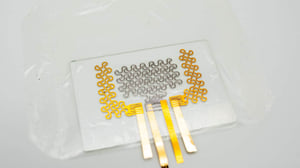Bioengineers from the University of Texas at Austin (USA) have created a device that could considerably facilitate the monitoring of heart patients, because, despite being as thin as a sticking plaster, it is capable of “measuring” heart health with great accuracy, in real time, without the need, therefore, for uncomfortable or heavy equipment.
As the researchers explain in the journal Advanced Science, the electronic tattoo, or e-tattoo (the name given to this kind of thin, stretchy device almost like a tattoo), collects both electrocardiogram (ECG) data and that of an examination known as a seismocardiogram (SCG), which measures chest vibrations associated with heartbeats. The simultaneous and synchronous processing of this data provides an extremely accurate assessment of the regularity of cardiac function. The tool normally used for seismocardiogram readings is much bulkier, and is affected by body movements. The prototype made in Austin, on the other hand, works thanks to ultrathin layers of a material called polyvinylidene fluoride (only 28 thousandths of a millimeter thick), inserted into a filamentary serpentine network.
Polyvinylidene fluoride was chosen because it has the property (defined as piezoelectric) that transforms the mechanical deformations – caused to the chest wall by heartbeats – into a measurable electrical charge. The best point to apply the “tattoo” (the thinnest of this type made up to now), according to the researchers, is the right mid-sternal region, but in any case the e-tattoo contains a system to obtain the best “centering” possible. The new device measures 63.5 x 38.1 x 0.122 millimeters and can also be worn for several consecutive days. Since the piezoelectric material can also be influenced by other body movements, in addition to those associated with the heart, a dual sensor system was added to the micro-device in order to cancel out the background “noise”.
The electronic tattoo is currently powered remotely via a smartphone, which records the data that can then be resent directly to a cardiologist. In the future there are also plans to make a completely wireless version. These studies have been financed by the National Institutes of Health and other US public institutions, such as the Air Force Office of Scientific Research.

